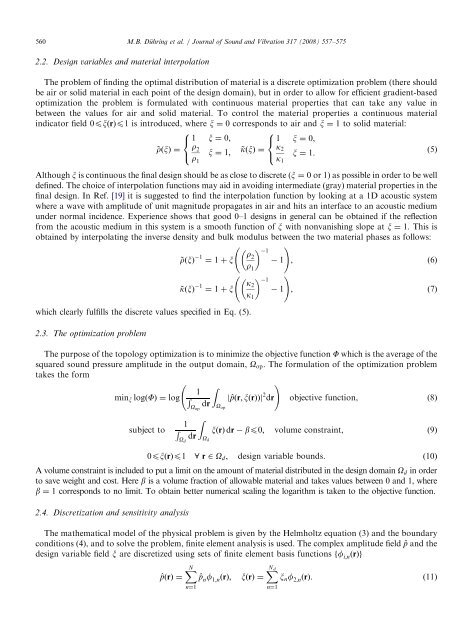Maria Bayard Dühring - Solid Mechanics
Maria Bayard Dühring - Solid Mechanics
Maria Bayard Dühring - Solid Mechanics
Create successful ePaper yourself
Turn your PDF publications into a flip-book with our unique Google optimized e-Paper software.
560<br />
2.2. Design variables and material interpolation<br />
The problem of finding the optimal distribution of material is a discrete optimization problem (there should<br />
be air or solid material in each point of the design domain), but in order to allow for efficient gradient-based<br />
optimization the problem is formulated with continuous material properties that can take any value in<br />
between the values for air and solid material. To control the material properties a continuous material<br />
indicator field 0pxðrÞp1 is introduced, where x ¼ 0 corresponds to air and x ¼ 1 to solid material:<br />
8<br />
8<br />
< 1 x ¼ 0; < 1 x ¼ 0;<br />
~rðxÞ ¼ r2 : x ¼ 1; ~kðxÞ ¼ k2<br />
: x ¼ 1:<br />
(5)<br />
r 1<br />
Although x is continuous the final design should be as close to discrete (x ¼ 0 or 1) as possible in order to be well<br />
defined. The choice of interpolation functions may aid in avoiding intermediate (gray) material properties in the<br />
final design. In Ref. [19] it is suggested to find the interpolation function by looking at a 1D acoustic system<br />
where a wave with amplitude of unit magnitude propagates in air and hits an interface to an acoustic medium<br />
under normal incidence. Experience shows that good 0–1 designs in general can be obtained if the reflection<br />
from the acoustic medium in this system is a smooth function of x with nonvanishing slope at x ¼ 1. This is<br />
obtained by interpolating the inverse density and bulk modulus between the two material phases as follows:<br />
~rðxÞ 1 !<br />
1<br />
r2 ¼ 1 þ x<br />
1 , (6)<br />
~kðxÞ 1 ¼ 1 þ x<br />
which clearly fulfills the discrete values specified in Eq. (5).<br />
2.3. The optimization problem<br />
r 1<br />
k2<br />
k1<br />
1<br />
k1<br />
1<br />
!<br />
, (7)<br />
The purpose of the topology optimization is to minimize the objective function F which is the average of the<br />
squared sound pressure amplitude in the output domain, Oop. The formulation of the optimization problem<br />
takes the form<br />
1<br />
minx logðFÞ ¼log R<br />
Oop dr<br />
Z<br />
j ^pðr; xðrÞÞj<br />
Oop<br />
2 !<br />
dr objective function, (8)<br />
subject to<br />
R<br />
1<br />
Od dr<br />
Z<br />
Od<br />
xðrÞ dr bp0; volume constraint, (9)<br />
0pxðrÞp1 8 r 2 Od; design variable bounds. (10)<br />
A volume constraint is included to put a limit on the amount of material distributed in the design domain Od in order<br />
to save weight and cost. Here b is a volume fraction of allowable material and takes values between 0 and 1, where<br />
b ¼ 1 corresponds to no limit. To obtain better numerical scaling the logarithm is taken to the objective function.<br />
2.4. Discretization and sensitivity analysis<br />
The mathematical model of the physical problem is given by the Helmholtz equation (3) and the boundary<br />
conditions (4), and to solve the problem, finite element analysis is used. The complex amplitude field ^p and the<br />
design variable field x are discretized using sets of finite element basis functions ff i;nðrÞg<br />
^pðrÞ ¼ XN<br />
ARTICLE IN PRESS<br />
M.B. <strong>Dühring</strong> et al. / Journal of Sound and Vibration 317 (2008) 557–575<br />
n¼1<br />
^p nf 1;nðrÞ; xðrÞ ¼ XNd<br />
n¼1<br />
x nf 2;nðrÞ. (11)
















